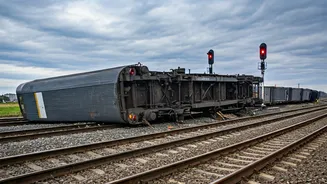Disaster Strikes Bilaspur
A calamitous train derailment in Bilaspur has led to considerable loss of life, casting a pall over the region. The initial reports indicated that a coach
of the train was severely damaged. Rescue teams were immediately mobilized to the site of the accident. Their foremost task was to extract passengers trapped within the mangled wreckage of the train carriage. These first responders worked tirelessly, employing specialized tools and equipment to navigate the challenging circumstances. The incident necessitated immediate attention, with a sense of urgency dominating the initial hours after the accident. The immediate focus was on saving lives and providing assistance to the injured.
Rescue Operations Begin
As soon as the accident occurred, the rescue teams swung into action. They were faced with the difficult task of freeing individuals trapped within the damaged coach. The teams consisted of railway officials, local emergency services, and volunteers who converged on the site. Cutting through twisted metal and debris proved to be a daunting task, requiring precision and resourcefulness. The scale of the accident demanded a coordinated effort, with teams working in tandem to search for survivors and provide crucial first aid. The entire operation was a race against time. The primary objective was to ensure the safe extraction of all those trapped and give immediate medical aid to the injured.
Casualties and Impact
The train collision resulted in a reported number of fatalities. The loss of life had a profound impact, not only on the immediate families affected but also on the larger community. The authorities had to confirm the identities of the deceased and to support the families. Alongside the tragic loss of life, numerous individuals sustained injuries. The injured were promptly transported to the local medical facilities. The severity of their injuries ranged from minor to critical. Hospitals and medical personnel worked to provide immediate care and treatment to the injured.
Train Services Affected
The railway services were inevitably disrupted following the Bilaspur train derailment. Multiple train routes had to be canceled. This disruption brought significant implications for travel across the region. Travelers were left facing delays and had to make alternative arrangements. The railway authorities initiated efforts to reroute trains to restore some level of connectivity. These changes resulted in extended travel times and increased passenger inconvenience. The long-term impact on the railways, including potential revisions to schedules and operations, will be felt in the coming days.
Investigation Launched
A formal investigation was launched immediately after the train collision. The investigation’s primary objective will be to determine the cause of the accident. Officials have been gathering evidence from the site, interviewing witnesses, and reviewing operational procedures. Determining accountability is crucial, and the investigation will look into any potential lapses in safety protocols. This includes the possibility of equipment failure, human error, or any other factors that may have contributed to the catastrophe. The findings of the investigation will be essential in preventing future incidents and ensuring rail safety.
Probe Aftermath
The aftermath of the train accident will likely require comprehensive steps to ensure accountability and to prevent similar incidents. Authorities will need to assess the structural integrity of the affected rail lines. This involves a complete inspection. Safety protocols and operational procedures are also under close scrutiny to identify potential vulnerabilities. This is an important part of the review process. There will likely be an increase in surveillance and maintenance. The overall goal is to establish a safer railway system, providing greater protection for passengers and railway personnel. This comprehensive approach is necessary to restore public confidence in rail travel.















